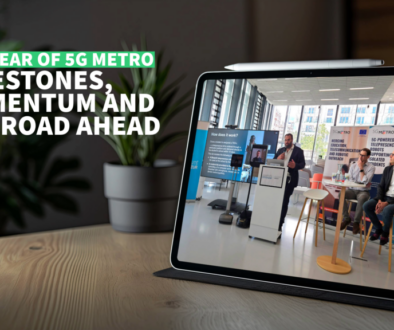As part of the 5G Metro project, Orange is deploying a cutting-edge 5G Standalone (SA) network to enhance digital inclusion and enable innovative use cases, such as telepresence robots for remote students.
To better understand the impact of this technology, we asked Sylvain Leroux, Smart Territories Marketing and Innovation Director at Orange and 5G Metro project coordinator, three key questions about the benefits of 5G SA, the choice of a Hybrid Private Mobile Network for the university campus, and how 5G Metro aligns with Orange’s broader vision for 5G innovation and digital inclusion.
How does Orange’s 5G Standalone (SA) network enhance the performance of telepresence robots compared to traditional networks?
The use of mobile telepresence robots on a campus requires very high stability of connection and a prioritisation of traffic versus the existing public network, whether 4G or Wi-Fi for example.
5G SA, with its higher frequencies and specific capabilities that allows network slices to be reserved for priority uses, offers better connection quality, availability and experience than previous-generation 4G networks.
For example, 5G offers theoretical speeds of up to 20 Gbit/s, compared with 1 Gbit/s for 4G+.
In addition, 5G offers a latency that can fall below 10 milliseconds (compared with 30 to 50 milliseconds for 4G), greatly improving the responsiveness of robots, for better movement and safety inside buildings.
Why deploy an Hybrid Private Mobile Network on a university campus, rather than a Private Mobile Network standalone?
Until now, most projects have been focused on providing Private Mobile Networks standalone, i.e. a dedicated, integrated and autonomous Private Mobile Network for businesses or industries with high security requirements. In this field, Orange Business is recognised as a Leader by Gartner in their 2025 Magic Quadrant for 4G and 5G Private Mobile Network Services.
However, on campuses such as IMREDD, which welcome a wide range of visitors including students, teachers, employees, visitors and external service providers, an Hybrid Private Mobile Network, via a unique mobile coverage, makes it possible to support both public and private uses for the efficient functioning of the campus.
By relying directly on the Operator’s network, different slices can be used for different types of usage, while guaranteeing the security of sensitive data and keeping it on the campus.
It’s also worth noting that, thanks to this type of network, you can use a single terminal and a single SIM card, resulting in operational gains.
How does the 5G Metro project fit into Orange’s broader vision for 5G innovation and digital inclusion?
In a fast-changing digital environment, Orange wants to be a committed player in current and future transformations, focusing in particularly on connectivity, 5G, large-scale Internet of Things, Artificial Intelligence, etc.
Our innovations are designed to help build a smarter, more open and more responsible society.
By adopting an open innovation approach, we are joining forces with numerous innovative ecosystems to help tomorrow’s solutions emerge more quickly, as is the case here with 5G.
In addition, thanks to our strong local presence, we are working to ensure that digital technology benefits to citizens, communities and regions.
Each Orange Group entity participates, at its own level, in the digital inclusion approach, by facilitating access to connectivity and preparing the networks of tomorrow; by maintaining and repairing the networks in all our geographies; by creating and running support and education programmes for digital use; by proposing inclusive offers and products, or even by supporting entrepreneurship and start-ups.




